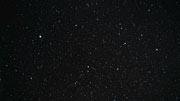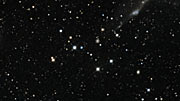Persbericht
‘Atomen voor de vrede’: een galactische botsing in actie
10 november 2010
Astronomen van de Europese Zuidelijke Sterrenwacht (ESO) hebben een spectaculaire nieuwe opname gemaakt van het beroemde ‘Atomen voor de vrede’-stelsel (NGC 7252). Deze kop-staartbotsing van twee sterrenstelsels biedt astronomen de gelegenheid om te onderzoeken hoe zulke galactische fusies van invloed zijn op de evolutie van het heelal.
‘Atomen voor de vrede’ is de merkwaardige bijnaam die gegeven is aan een tweetal botsende sterrenstelsels op een afstand van 220 miljoen lichtjaar in het sterrenbeeld Waterman. Het duo staat ook bekend als NGC 7252 of Arp 226 en is net helder genoeg om door amateurastronomen als een zwak lichtvlekje te worden waargenomen. Deze meer dan vier uur belichte opname is gemaakt met ESO’s Wide Field Imager van de 2,2-meter MPG/ESO-telescoop van de ESO-sterrenwacht op La Silla (Chili).
Botsingen tussen sterrenstelsels behoren tot de meest bepalende processen in de evolutie van ons heelal. Het onderzoek ervan kan belangrijke informatie opleveren over de voorlopers van de huidige sterrenstelsels. Gelukkig zijn zulke botsingen langdradige gebeurtenissen die honderden miljoenen jaren in beslag nemen. Astronomen hebben dus tijd genoeg om ze te bestuderen.
Deze foto van NGC 7252 is slechts een momentopname van een chaotische gebeurtenis die nog in volle gang is. De gevolgen van het delicate krachtenspel tussen de betrokken stelsels komen tot uiting in de vormen van de twee ‘staarten’, die uit sterren, gas en stof bestaan. De foto toont ook de verbluffende schillen die ontstonden doordat gas en sterren werden verstoten uit de botsende stelsels en om hun gezamenlijke centrum werden gewikkeld. Hoewel veel materie de ruimte in verdween, werden andere gebieden samengedrukt en tot grootschalige stervorming aangezet. Het resultaat was de geboorte van honderden sterrenhopen, die nog maar 50 tot 500 miljoen jaar oud zijn. Vermoed wordt dat dit de voorlopers van bolvormige sterrenhopen zijn.
‘Atomen voor de vrede’ is wellicht een voorbode van wat ons eigen Melkwegstelsel te wachten staat. Astronomen voorspellen dat ons stelsel over drie tot vier miljard jaar in botsing komt met het Andromedastelsel, precies zoals dat nu met NGC 7252 is gebeurd. Maar geen paniek: de afstanden tussen de sterren in een sterrenstelsel zijn enorm groot. Het is dus niet waarschijnlijk dat onze zon tijdens deze fusie in botsing komt met een andere ster.
De merkwaardige bijnaam van het object kent een interessante geschiedenis. In december 1953 gaf de Amerikaanse president Eisenhower een toespraak met de titel ‘Atomen voor de vrede’. Onderwerp was het stimuleren van kernenergie voor vreedzame doeleinden – destijds een bijzonder veelbesproken kwestie. De toespraak en de bijbehorende conferentie veroorzaakten binnen en buiten de wetenschappelijke gemeenschap de nodige beroering. Zodanig zelfs dat NGC 7252 tot ‘Atomen voor de vrede’-stelsel werd gedoopt. In verschillende opzichten was dat zeer toepasselijk: de merkwaardige vorm die we zien is het gevolg van twee sterrenstelsels die tot een veel groter geheel fuseren – ongeveer zoals bij een atoomfusie. Bovendien doen de reusachtige lussen van NGC 7252 denken aan de tekeningen van elektronen die om een atoomkern draaien, zoals je die in schoolboeken aantreft.
Meer informatie
ESO, de Europese Zuidelijke Sterrenwacht, is de belangrijkste intergouvernementele sterrenkundeorganisatie in Europa, en het meest productieve astronomische observatorium ter wereld. ESO wordt ondersteund door 14 landen: België, Denemarken, Duitsland, Finland, Frankrijk, Italië, Nederland, Oostenrijk, Portugal, Spanje, Tsjechië, het Verenigd Koninkrijk, Zweden en Zwitserland. ESO voert een ambitieus programma uit, gericht op het ontwerp, de bouw en het beheer van krachtige grondobservatoria die astronomen in staat stellen om belangrijke wetenschappelijke ontdekkingen te doen. ESO speelt ook een leidende rol bij het bevorderen en organiseren van samenwerking op sterrenkundig gebied. ESO beheert drie waarnemingslocaties van wereldklasse in Chili: La Silla, Paranal en Chajnantor. Op Paranal staat ESO’s Very Large Telescope (VLT), de meest geavanceerde optische sterrenwacht ter wereld. Ook is ESO de Europese partner van de revolutionaire telescoop ALMA. Daarnaast is ESO momenteel bezig met ontwerpstudies voor de 42-meter Europese Extremely Large optische/nabij-infrarood Telescoop (E-ELT), die ‘het grootste oog op de hemel’ ter wereld zal worden.
Contact
Richard Hook
ESO, La Silla, Paranal, E-ELT and Survey Telescopes Public Information Officer
Garching bei München, Germany
Tel: +49 89 3200 6655
Mobiel: +49 151 1537 3591
E-mail: rhook@eso.org
Marieke Baan (Perscontact Nederland)
ESO Science Outreach Network
en NOVA Informatie Centrum
Tel: +31(0)20-5257480
E-mail: eson-netherlands@eso.org
Over dit bericht
| Persberichten nr.: | eso1044nl |
| Naam: | NGC 7252 |
| Type: | Milky Way : Galaxy : Type : Interacting |
| Facility: | MPG/ESO 2.2-metre telescope |
| Instruments: | WFI |
Our use of Cookies
We use cookies that are essential for accessing our websites and using our services. We also use cookies to analyse, measure and improve our websites’ performance, to enable content sharing via social media and to display media content hosted on third-party platforms.
ESO Cookies Policy
The European Organisation for Astronomical Research in the Southern Hemisphere (ESO) is the pre-eminent intergovernmental science and technology organisation in astronomy. It carries out an ambitious programme focused on the design, construction and operation of powerful ground-based observing facilities for astronomy.
This Cookies Policy is intended to provide clarity by outlining the cookies used on the ESO public websites, their functions, the options you have for controlling them, and the ways you can contact us for additional details.
What are cookies?
Cookies are small pieces of data stored on your device by websites you visit. They serve various purposes, such as remembering login credentials and preferences and enhance your browsing experience.
Categories of cookies we use
Essential cookies (always active): These cookies are strictly necessary for the proper functioning of our website. Without these cookies, the website cannot operate correctly, and certain services, such as logging in or accessing secure areas, may not be available; because they are essential for the website’s operation, they cannot be disabled.
Functional Cookies: These cookies enhance your browsing experience by enabling additional features and personalization, such as remembering your preferences and settings. While not strictly necessary for the website to function, they improve usability and convenience; these cookies are only placed if you provide your consent.
Analytics cookies: These cookies collect information about how visitors interact with our website, such as which pages are visited most often and how users navigate the site. This data helps us improve website performance, optimize content, and enhance the user experience; these cookies are only placed if you provide your consent. We use the following analytics cookies.
Matomo Cookies:
This website uses Matomo (formerly Piwik), an open source software which enables the statistical analysis of website visits. Matomo uses cookies (text files) which are saved on your computer and which allow us to analyze how you use our website. The website user information generated by the cookies will only be saved on the servers of our IT Department. We use this information to analyze www.eso.org visits and to prepare reports on website activities. These data will not be disclosed to third parties.
On behalf of ESO, Matomo will use this information for the purpose of evaluating your use of the website, compiling reports on website activity and providing other services relating to website activity and internet usage.
Matomo cookies settings:
Additional Third-party cookies on ESO websites: some of our pages display content from external providers, e.g. YouTube.
Such third-party services are outside of ESO control and may, at any time, change their terms of service, use of cookies, etc.
YouTube: Some videos on the ESO website are embedded from ESO’s official YouTube channel. We have enabled YouTube’s privacy-enhanced mode, meaning that no cookies are set unless the user actively clicks on the video to play it. Additionally, in this mode, YouTube does not store any personally identifiable cookie data for embedded video playbacks. For more details, please refer to YouTube’s embedding videos information page.
Cookies can also be classified based on the following elements.
Regarding the domain, there are:
- First-party cookies, set by the website you are currently visiting. They are stored by the same domain that you are browsing and are used to enhance your experience on that site;
- Third-party cookies, set by a domain other than the one you are currently visiting.
As for their duration, cookies can be:
- Browser-session cookies, which are deleted when the user closes the browser;
- Stored cookies, which stay on the user's device for a predetermined period of time.
How to manage cookies
Cookie settings: You can modify your cookie choices for the ESO webpages at any time by clicking on the link Cookie settings at the bottom of any page.
In your browser: If you wish to delete cookies or instruct your browser to delete or block cookies by default, please visit the help pages of your browser:
Please be aware that if you delete or decline cookies, certain functionalities of our website may be not be available and your browsing experience may be affected.
You can set most browsers to prevent any cookies being placed on your device, but you may then have to manually adjust some preferences every time you visit a site/page. And some services and functionalities may not work properly at all (e.g. profile logging-in, shop check out).
Updates to the ESO Cookies Policy
The ESO Cookies Policy may be subject to future updates, which will be made available on this page.
Additional information
For any queries related to cookies, please contact: pdprATesoDOTorg.
As ESO public webpages are managed by our Department of Communication, your questions will be dealt with the support of the said Department.





